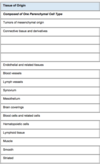9_Neoplasia Flashcards
neoplastic cells:
define, regulation
- def: Transformed cells as they continue to replicate
- regulation
- Certain degree of autonomy
- Oblivious to regulatory influences that control normal growth
neoplasm/neoplasia:
define, growth, regulation
- define: an abnormal mass of tissue,
- growth of which is uncoordinated with that of normal tissues,
- regulation:
- persists in the same excessive manner after the cessation of the stimulus which evoked the change
- with the loss of responsiveness to normal growth controls
tumor:
other name; & benign vs malignant
- commonly used to refer to neoplasms
- types based on clinical behavior:
-
Benign: Relatively innocent,
- implying that it will remain localized and is amenable to local surgical removal
-
Malignant: “Cancers”,
- implies that the lesion can invade and destroy adjacent structures and spread to distant sites
-
Benign: Relatively innocent,
basic components of tumor:
define parenchyma and stroma
- Parenchyma: proliferating neoplastic cells
- Stroma: supportive tissue composed of connective tissue and blood vessels
(These 2 interact)
desmoplasia:
define
a¡dense collagenous stromal reaction to invasive tumor
nomenclature of benign tumors:
suffix, mesenchymal, and epithelial

describe the presentation of the following benign tumors:
adenoma
papilloma
cystadenoma
- adenoma - glandular pattern (shows glands histologically)
- papilloma - finger-like or warty surface projections
- cystadenoma - tumors forming large cystic masses
define:
hyperchromasia
dysplasia
- hyperchromasia: dark staining nuclei which is usually due to increased DNA content.
- dysplasia: abnormal development of cells within tissues or organs
polyp:
histology; term is assoc. w/ which tumors?
- Macroscopically visible projection above the mucosal surface
- Preferably restricted to benign tumors; malignant ones better designated as polypoid carcinomas

nomenclature of malignant tumors
origin, mesenchymal, epithelial
- Organ of origin is usually specified
- Undifferentiated
- Mesenchymal: sarcomas
- Epithelial cell origin: carcinomas
- Adenocarcinoma (glandular pattern)
- Squamous carcinoma (Squamous cells)
mixed tumors:
define
derived from divergent differentiation of a single line of parenchymal cells from a single germ cell layer
- Pleomorphic adenoma

teratomas:
define
composed of cell types from multiple germ cell layers
name the benign and malignant names for the following:


what are the benign and malignant names for the following?


match the benign and malignant name for the following tissues of origin


non-neoplastic masses are sometimes confused w/ neoplasms:
what are the following?
- ectopic rest of normal tissue
- mass of disorganized but mature specialized cells or tissue indigenous to the particular site
- localized collection of blood in tissues or a body
- Choristoma: ectopic rest of normal tissue
- Hamartoma: mass of disorganized but mature specialized cells or tissue indigenous to the particular site
- Hematoma: localized collection of blood in tissues or a body
what are the 4 fundamental features by which benign and malignant tumors can be distinguished?
- differentiation and anaplasia
- rate of growth
- local invasion
- metastasis
differentiation:
- define,*
- benign vs. malignant*
extent to which neoplastic cells resemble comparable normal cells, morphologically and functionally
- Benign tumors are usually well differentiated
- Malignant tumors range from well to undifferentiated
which type of tumor cells are typically WELL-DIFFERENTIATED?
benign cells are usually well differentiated
(meaning they well-differentiated cancer cells look more like normal cells and tend to grow and spread more slowly than poorly differentiated or undifferentiated cancer cells)
anaplasia:
- define*
- morphological changes*
- the lack of differentiation; hallmark of malignancy
- malignant tumors are typically UNDIFFERENTIATED
- morphologic changes
- (Pleomorphism) variation in cell size and shape
- Atypical, bizarre mitotic figures
- Loss of polarity
- Nuclear changes
- Hyperchromasia
- Increased nuclear/cytopasmic ratio
- Variable nuclear shape
- Coarse, clumped or unevenly distribute chromatin
- Large/ multiple nucleoli
dysplasia:
where does this occur, characterized by?
- encountered principally in epithelium
- considered PRE-MALIGNANT
- characteristics:
- loss in uniformity of individual cells
- loss in architectural orientation
Carcinoma in-situ:
define, and progression?
- dysplasia in which the changes involve the entire thickness of the epithelium (pre-invasive)
- does not necessarily progress to invasive cancer
rate of growth:
benign tumors
- Nearly all grow as cohesive expansile masses that remain localized to their site of origin
- Lack capacity to infiltrate, invade or metastasize
- Usually develop a fibrous capsule
- Remain discrete, readily palpable and easily moveable
- Enucleated surgically
rate of growth:
malignant tumors
- Growth is accompanied by progressive infiltration, invasion and destruction of surrounding tissues
- Lack a well-defined boundary
- Invasion is reliable in distinguishing benign from malignant



